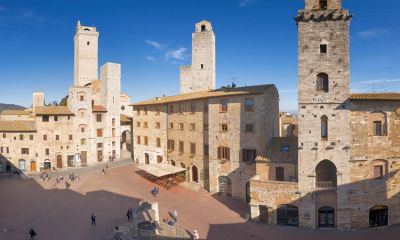Sam Gimignano è un piccolo paese della Toscana, vicino a Siena. Molti anni fa, era un posto di risposo per le persone che camminavano da Firenze a Roma. Il villaggio è pieno di storia. I primi documenti che menzionano la città devono essere almeno più di mille anni fa. La città si trova sulle colline della Toscana. La città originaria aveva 72 torri ma ora ci sono solo 13. Molte persone visitano San Gimignano per una giornata quando stanno Firenze. Benché sia una piccola città, ancora ha tanta storia e tanta bellezza.
San Gimignano is an Italian hill town in Tuscany, southwest of Florence. Encircled by 13th-century walls, its old town centers on Piazza della Cisterna, a triangular square lined with medieval houses. It has a skyline of medieval towers, including the stone Torre Grossa. The Duomo di San Gimignano is a 12th-century church with frescoes by Ghirlandaio in its Santa Fina Chapel.
The foundation of San Gimignano dates back to ancient times. According to legend, in 63 B.C. two brothers, Muzio and Silvio, two young patricians escaping from Rome after their implication in the conspiracy of Catiline, sheltered in Valdelsa and built two castles: the Castle of Mucchio and the Castle of Silvia, which would develop in the future San Gimignano.
The first historical document mentioning the name of the town is dated August 30, 929, when Ugo di Provenza donated to the Bishop of Volterra the so-called Mount of the Tower "prope Sancto Geminiano adiacente" (next to San Gimignano). The name of San Gimignano probably comes from the bishop of Modena. According to legend, during the barbaric invasions the saint appeared miraculously on the city walls, and saved the town from Totila's threat.
In 998 San Gimignano was still a village along the Via Francigena. From a political point of view, it belonged to the bishop of Volterra, who resided in a castle at Poggio della Torre. San Gimignano mainly developed in the first three centuries of the Millennium, thanks to its favorable geographical position.
San Gimignano rises on top of a hill 334m above sea level, clearly visible in the distance with its many towers. Today 13 towers remain of the 72 towers of the 14th century, when every well-off family built a tower to show its economic power (many of them are still visible in the buildings, even if they were cut off).
“A stroll through the core of San Gimignano, in the shadows of its surviving towers, is a delight. As the town was about a day's trek to Siena or Florence in the Middle Ages, it was a good stopover for pilgrims en route from those cities to Rome. Near the main gate, you can still see the remains of a 12th-century pilgrims' shelter” writes www.ricksteves.com.
In 1990, San Gimignano was declared a UNESCO World Heritage Site. Today visitors can see holy art, take guided tours, dine at local restaurants and enjoy Vernaccia di San Gimignano, the famous white wine of Tuscany.



